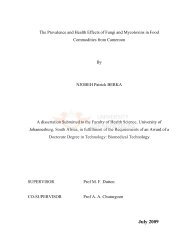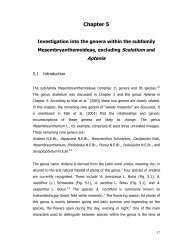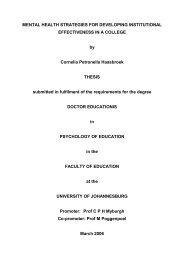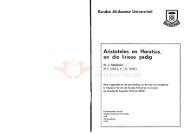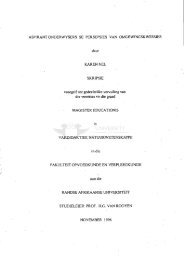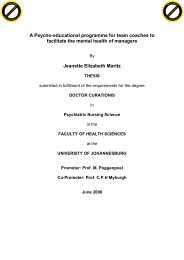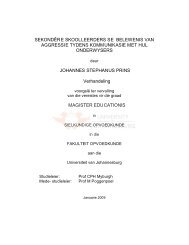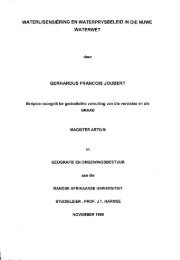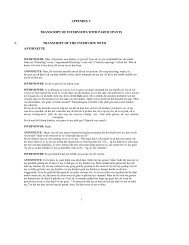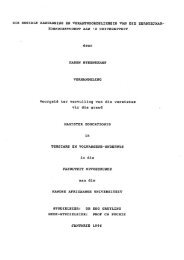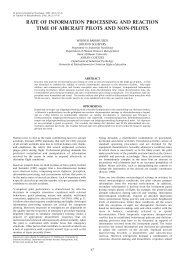View/Open - UJDigispace
View/Open - UJDigispace
View/Open - UJDigispace
You also want an ePaper? Increase the reach of your titles
YUMPU automatically turns print PDFs into web optimized ePapers that Google loves.
ABJECT NEGOTIATIONS: THE MUTABILITY OF IDENTIFICATION IN SELECTED ARTWORKS BY BERNI SEARLE<br />
ofabjection evident in Searle's work is a slippery, dynamic, open-endedness.<br />
In Searle's work, meaning and identity are presented - formed - as<br />
ambiguous and in antithesis to one naturalised truth. Clive Kellner (2006:17)<br />
quotes Searle as saying "[t]he self is explored as an ongoing process of<br />
construction in time and place. The presence and absence ofthe body in the<br />
work point to the ideal that one's identity is not static, and is constantly in<br />
a state offlux". Searle's work relies on liminality; a sense and a positioning<br />
of being both in-between and overlapping the boundaries of naturalised<br />
identity. This marginal state of flux and space of ambiguity seems to be<br />
what Rory Bester (2003:53) describes as "imagined identities ... [which]<br />
allow Searle to float free from the immutable identities so ingrained in her<br />
history". To this end, Searle uses ephemeral and unstable media in conjunc<br />
tion with her body as medium, to explore concepts of identity, desire and<br />
memory.<br />
In her work, Searle shows conceptions of race, identity and memory<br />
to be dynamic, often contradictory self-negotiations; mutable processes of<br />
negotiation rather than naturalised categorisations. Through her reference<br />
to multiple racial categories, geographic origins and historic narratives,<br />
Searle presents identity as ambiguous and open-ended. This understanding<br />
of a negotiable identity is what draws me to Searle's work and forms the<br />
focus ofthis paper.<br />
In this paper, I offer a reading of selected works by South (Figs. 2a & 2b) I focus onwhat I argue to be tactile, abject and<br />
African artist Berni Searle in relation to the post-structural, semiotically-driven elements in her open-ended negotiapsychoanalytic<br />
theories ofJulia Kristeva. In examining tions ofself-identity. I propose that Searle's use oftactility<br />
Searle's representations ofcorporealityand use ofthe formal disrupts the pervasive naturalisation or the accession into<br />
elements oftactility, I draw tentative analogies between the 'sameness' characteristic of the symbolic element within<br />
tactility evident in her work and two Kristevian theories signification.<br />
of heterogeneity, namely, the abject' and the semiotic (see<br />
Pollock 1998:9). Through an analysis of Searle's video I locate this investigation of tactility within Searle's<br />
work About to forget (2005) (Fig. 1) and the photographic works with reference to an assertion of a non-gendered<br />
stills developed from this work titled On either side (2005) form of embodied representation. I share Liese van der<br />
108 IMAGING OURSELVES
Watt's (2004a:69) view that Searle's work questions more<br />
than just racialised or, I would suggest, gendered identity.<br />
Rather, as van der Watt (2004a:[sp]) notes, it challenges<br />
the very concept ofidentity itself, precisely by conceptualising<br />
the self in an inter-subjective, contingent way. By insistently<br />
visuaIising the body/selfshe proposes identity as performative,<br />
never inherent.<br />
My attempt atlocatinga readingofSearle's work outside, but<br />
not exclusive of the politics of gender and race, is achieved<br />
through a focussed exploration ofhow a sense ofambiguity<br />
may be suggested in visual representation through a mobilisation<br />
ofthe semiotic. Kelly Oliver (1993:156) notes that<br />
Kristeva prefers to discuss difference in generaL rather than<br />
sexual difference ... [her] concern with difference in general<br />
underlines her concern to multiply representations ofvarious<br />
sexed bodies that do not limit us to just masculine or feminine<br />
or male and female.<br />
In other words, through the application ofKristeva's noticeably<br />
non-gendered model ofembodied subjectivity, namely<br />
the speaking subject, I hope to avoid an understanding of<br />
the negotiations of self-identification organised primarily<br />
around the politics ofgender and race 2 (Lechte & Margaroni<br />
2004:23-24). This model positions subjectivity as "always<br />
in process and heterogeneous" (McAfee 2004:41). As I note<br />
later in this paper, writers such as Clive Kellner (2006),<br />
Rory Bester (2003), Liese van der Watt (2004) and Emma<br />
Bedford (2003) as well as Searle (2006) herself, comment<br />
that within her work, identity is in a constant state offlux. In<br />
my understanding, it is through Searle's privileging oftactility<br />
and evocation ofthe abject that the spacious, open-ended<br />
negotiations ofthe speaking subject's identity is suggested.<br />
I offer that in Searle's work, through the performative use<br />
of her body and her reliance on tactile characteristics, she<br />
foregrounds a suggestion of corporeality. Leora Farber<br />
(1992:3) notes that artworks that favour a tactile approach<br />
have one or more of the following characteristics "textural<br />
articulation ... fragmentation, indeterminacy and dispersal"<br />
as well as a suggestion ofopen-endedness. In my understanding,<br />
the semiotic, bodily drive fuels tactility. Consequently,<br />
I propose that Searle's works, which rely on some of these<br />
tactile characteristics and that place emphasis on disruptive<br />
bodily drives, might be considered as visual representations<br />
ofthe semiotic, and through theirdisruption ofthe symbolic<br />
element, are evocative of an abject state.<br />
The symbolic element is, according to Noelle McAfee<br />
(2004:17), a "way of signifYing that depends on language<br />
as a sign system complete with its grammar and syntax";<br />
it is characterised by stability, unity and order (McAfee<br />
2004:22). Kristeva (cited in McAfee 2004:17) suggests that<br />
ABJECT NEGOTIATIONS: THE MUTABILITY OF IDENTIFICATION IN SELECTED ARTWORKS BY BERNI SEARLE<br />
this unambiguous, rational element may be "destabilized<br />
or unsettled by [the] semiotic drives and articulation". This<br />
disruption ofthe element of,sameness' throughthe ambiguously<br />
bounded semiotic element finds correlation with and<br />
results in the disruption ofthe normative conceptualisation<br />
of the self as a static, homogenous bounded unit inherent<br />
within Cartesian thought (van der Watt 2004a:68).3<br />
The privilegingofthe semiotic elementwithin the processes<br />
ofidentification leads to an understanding ofthe selfinwhich<br />
the "self [mind] and the body are chiasmically intertwined<br />
... [T]he self [is] presented as 'an embodied performance'"<br />
(Jones cited in van derWatt 2004a:68). As van derWatt notes<br />
(2004a:68) this "corporeal turn" challenges the Cartesian<br />
understanding ofthe body being "entirely distinct from the<br />
mind". I contend thatthis blurringofthe boundaries between<br />
body and mind is, in Searle's work, extended to a suggestion<br />
ofthe blurringbetween selfand 'other'. This is what, in part,<br />
evokes a reading ofthe abject. As Kristeva (1991:1) writes:<br />
ls]trangely, the foreigner lives within us: he is the hidden face<br />
ofour identity, the space that wrecks our abode, the time when<br />
understandingand affinity flounder. By recognisinghim within<br />
ourselves, we are spared detesting him in himself.<br />
I read About to forget (2005) and On either side (2005) as<br />
examples of how this semiotic disruption has the potential<br />
to evoke an experience ofabjection through the suggestion<br />
of an ambiguous sense of identity. This fluid working of<br />
identity finds correlation with Kristeva's understanding<br />
of the speaking subject. In the first section of this paper I<br />
briefly detail Kristeva's conception of the speaking subject,<br />
the semiotic element and the abject. Thereafter, I apply these<br />
concepts in a reading ofthe aforementioned works.<br />
Inherent in Kristeva's model of subjectivity, the speaking<br />
subject - which relies on the dialectic between symbolic<br />
and semiotic elements - is the suggestion of mutability<br />
between similarity and difference; of an intermingling of<br />
self and 'other'. Gabeda Baderoon (2006a:17), following<br />
cultural theorist Stuart Hall, notes that within post-colonial<br />
thought the process of identification is conceived of as a<br />
porous, ambiguous negotiation, "a production that is never<br />
complete." In support of this understanding is Desiree<br />
Lewis's (2001:112) observation that Searle's work bears<br />
reference to Hall's privileging ofthe term 'identification' over<br />
'identity'. Lewis (2001:112) explains this distinction by noting<br />
that Searle's work "marks a move away from an essentialist<br />
claiming of identity to a more cautious investigation of<br />
what identification means". This, Lewis (2001:112) notes, is<br />
achieved through an assertion of the understanding "that<br />
creativity which resists canons, restriction, official political<br />
and aesthetic labels can only be a form of being in process,<br />
a ... struggle through the debris of... cultural legacy". Lewis<br />
IMAGING OURSELVES 109
"<br />
ABJECT NEGOTIATIONS: THE MUTABILITY OF IDENTIFICATION IN SELECTED ARTWORKS BY BERNI SEARLE<br />
(2001:112) understands identification as a process rather<br />
than an assertion of a static subjectivity or "monolithic<br />
and idealistic celebration ofselfhood". Additionally, within<br />
these processes of identification, identity is constituted<br />
as a heterogeneous negotiation, rather than as a given,<br />
homogenised unity.<br />
Kristeva's 'speaking subject' or 'subject in process' is<br />
constituted through signification (Kristeva 1984:22).<br />
As she suggests, 'significance' is the meaning produced<br />
through the continuous dialectic negotiation between the<br />
seemingly oppositional elements of the semiotic and the<br />
symbolic (McAfee 2004:38). For Kristeva (1980:18), the<br />
semiotic is the motile, bodily driven element that functions<br />
in "heterogeneous articulation" with the symbolic element<br />
within the dialectic ofsignification (McAfee 2004:38). It is<br />
this articulation that "enables a text to signifY what representation<br />
and communicative speech [the symbolic element]<br />
does not say" (Kristeva 1980:18). By this I understand<br />
that Kristeva views the signifYing process of the speaking<br />
subject as the manner in which "bodily drives and energyare<br />
expressed ... [and] discharged through our use oflanguage"<br />
(McAfee 2004:14). As Maria Margaroni (2005:79) notes,<br />
Kristeva conceives ofthe semiotic as "asignifYing operation<br />
based on traces and marks rather than signs, the marks of<br />
the drives on the speaking body, the traces of what Freud<br />
calls the primary processes". I pick up this suggestion of<br />
bodily traces or residues in my analysis ofSearle's About to<br />
forget (2005) and On either side (2005).<br />
Within Kristeva's conception of the speaking subject, the<br />
semiotic and symbolic elements are not conceived of as<br />
opposition values within a duality. Rather, within her<br />
understanding of the 'subject in process' the "non-oppositional<br />
antagonism" (Lechte & Margaroni 2004:22, 30) of<br />
the semiotic and symbolic allows for a process of renewal,<br />
of transgression, of construction and deconstruction.<br />
Kristeva's speaking subject is an understanding of self in<br />
process, always questioning, testing, challenging. Kristeva<br />
(2002:440) refers to this as an "intimate revolt". The<br />
speaking subject through its signification process is "continually<br />
forced to test its limits" (Lechte & Margaroni 2004:23).<br />
This "form ofcontinual questioning ... enables, renews, and<br />
restructures both the individual and community" (Oliver<br />
2004:4) as it suggests a selfwhich is continuously formed<br />
"in relation to others rather than completewithin itself" (van<br />
der Watt 2004a:68). It is this element of inter-subjectivity,<br />
"the spilling over of arbitrary boundaries" (van der Watt<br />
2004a:68) ofselfand 'other' which is echoed in the ambiguous<br />
boundaries suggested by the formal elements oftactility.<br />
Oliver (1993:12) succinctly writes that the speaking subject<br />
"is a reconception ofthe relationship between identity and<br />
112 IMAGING OURSELVES<br />
difference". Oliver (1993:12) notes that Kristeva's writing is<br />
concerned with various stages ofidentity and difference. she<br />
insists on diagnosing the difference atthe heart ofidentity and<br />
the stases operatingwithin difference. The logic ofidentity and<br />
difference is the logic ofsubject and other. Alterity, otherness,<br />
and the stranger are always at the centre ofher texts.<br />
For Kristeva (2004:38), the disruptive, liminal influence of<br />
the semiotic is a positive provocation, creatingthe speaking<br />
subject's instability; its ability to change. The significant<br />
departure between Kristeva's "subject in process" (McAfee<br />
2004:30) andJacques Lacan's understanding ofthe speaking<br />
subject is Kristeva's insistence that the traces ofthe chora,<br />
as evidenced by the semiotic drive, are not repressed but<br />
rather vitally present in the processes of signification. 4<br />
This contrasts with Lacan's theory, as he suggests that upon<br />
entry into the Symbolic order,S through which the infant<br />
gains language and anidentifYing understanding ofitselfas<br />
separatefrom its mother, the pre-linguistic bodily drives and<br />
energies ofthe undifferentiated ofthe choraarelost (McAfee<br />
2004:35,38; Lechte & Margaroni 2004:14). It is through the<br />
"traces and marks" (Margaroni 2005:79) ofthe body evoked<br />
by the motile semiotic element that Kristeva seeks to bring<br />
the body back into language (Lechte & Margaroni 2004:23).<br />
Through her understanding of the speaking subject and<br />
the incorporation and focus on bodily drives and energy<br />
as one half of the signifYing process, Kristeva disrupts the<br />
Sartrean ideal of the disembodied, pure self (mind) free of<br />
the compromising desires and needs of the body. Karsten<br />
Harries (1968:85-87) points out that, for Jean-Paul Sartre,<br />
man's [sic] pride and desire to be autonomous and therefore<br />
god-like "rules out any possibility ofa reconciliation ofthe<br />
spirit and the flesh". The threat of the body, symbolised<br />
by the amorphous, ambiguously bounded "flaccid ooze"<br />
(Krauss 2005:397) that Sartre views as contaminatory and<br />
abject is, in Kristeva's speaking subject/subject in process,<br />
intricatelybound up withthe processes ofself-identification.<br />
Through this suggestion of ambiguous boundaries, of<br />
merging of selfand 'other', I read the abject as being a vital<br />
part ofthe constant negotiation ofself. This dynamic oscillation<br />
between order and disorder, and the vital interrelationship<br />
of self and 'other', locates the speaking subject as<br />
operating from a space of ambiguity. In my understanding,<br />
artworks that privilege tactile characteristics, and in which<br />
defining outer contours are disrupted and in parts dissolved,<br />
suggest the element ofopen-endedness within the abject.<br />
Likewise, the abject challenges and threatens the defining<br />
and orderingborders ofselfhood (Patin & McLerran 1997:1).<br />
For Kristeva, any phenomenon which disturbs bodily<br />
boundaries and consequently disrupts asense ofwholeness<br />
and purity may be defined as abject. This threat towards
the identity of one's "own clean and proper self" (McAfee<br />
2004:129) is considered abject and rejected, physically<br />
and/or mentally, yet is never completely removed (McAfee<br />
2004:45-49). From the speaking subject's position, and<br />
within abjection, identity is never static, nor constituted<br />
through the essentialised categorisation ofwhat defines self<br />
in antithesis to 'other', since what is viewed as abject and<br />
thus 'other' is never successfully removed from self.<br />
Kristeva's conception of the abject underpins this paper.<br />
It is this rite of passage that initialises the formation of<br />
the speaking subject and that has the potential to disrupt<br />
the symbolic drive by asserting the bodily presence of the<br />
semiotic drive. Derek Hook (2004:690) notes the intimate<br />
link between the semiotic and the abject. In support of<br />
this, Hook (2004:690) refers to Elizabeth Grosz (1990:86)<br />
who observes that "[a]bjection attests to the perilous and<br />
provisional nature ofthe symbolic control over the dispersing<br />
impulses of the semiotic drives, which strive to break<br />
down and through identity, order, and stability". In other<br />
words, the abject elicits a reaction of horror and disgust<br />
from the subject by threatening a return to an undifferentiated,<br />
pre-identity, chora-like state. Additionally, through a<br />
suggestion ofambiguous boundaries, the semiotic element<br />
challenges the ordered, bounded structure ofthe symbolic<br />
element within language.<br />
The dominant mode ofsignificationwithin Kristeva's model of<br />
the speakingsubject - the semiotic - challenges and partially<br />
disrupts the homogeneity of the symbolic, unsettling neat<br />
borders of selfhood. This disruption demonstrates and<br />
emphasises "the subject's Lack of unity" (McAfee 2004:38<br />
39). Accordingto McAfee (2004:38-43) Kristeva argues that<br />
because ofthese continuous disruptions in signification the<br />
speaking being is always "a subject in process"; subjectivity<br />
is never 'fixed' or stationary. In my understanding, this<br />
disruption is abject in nature as it disturbs the notion ofa<br />
bounded, unified self. The abject may be observed operating<br />
within various discourses. In a psychoanalytic understanding<br />
the abject is suggested through an ambiguity between<br />
boundaries of self and 'other' (Lloyd-Smith 2005:193-194).<br />
From an anthropological standpoint, dirt or its socialised<br />
equivalent, defilement, may evoke a state of abjection<br />
(Lloyd-Smith 2005:193-194). Regardless of this perspective,<br />
the reaction of disgust that is evoked by the abject<br />
is valuable to negotiations of self-identification (Meagher<br />
2003). Phrased differently, the destabilisation ofboundaries<br />
should not be viewed as a solely negative, destructive force.<br />
As per Kristeva's suggestionofanintimate revolt, the abject's<br />
challenge to boundaries may be a useful tool in the opening<br />
up ofsystems ofrepresentation. Oliver (1993:8) echoes this<br />
when noting that within Kristeva's understanding "types of<br />
language or signifying practices that attend to this semiotic<br />
ABJECT NEGOTIATIONS: THE MUTABILiTY OF IDENTIFICATION IN SELECTED ARTWORKS BY BERNI SEARLE<br />
element" are not only useful as methods of catharsis, but<br />
more importantly through their use "our traditional or<br />
dominant discourses and representations can be changed".<br />
Language and identity are interrelated, and therefore this<br />
"revolt against the fixed meaning of symbolic discourse<br />
[by] consideringthe revolutionary potential ofsemiotically<br />
charged language" may be said to positively impact upon the<br />
speaking being (McAfee 2004:113).<br />
As noted, in Searle's work, identity is presented- and formed<br />
- as ambiguous, as often contradictory (self) negotiations,<br />
mutable processes ofnegotiation that function in contradiction<br />
to an adherence ofone naturalised truth. In a statement<br />
that echoes this dynamic character ofthe speaking subject,<br />
Kellner (2006:17) quotes Searle as saying, "[t]he self is<br />
explored as an ongoing process ofconstruction in time and<br />
place. The presence and absence of the body in the work<br />
point to the ideal that one's identity is not static, and is<br />
constantly in a state offlux". I offer that Searle explores this<br />
subtle workingof(self)identitythrough the use ofthe abject,<br />
in a manner analogous to Rosemary Betterton's (1996:144)<br />
observation that whilst "the vulnerability ofthe borderline<br />
is a threat to the integrity ofthe 'own and clean self' (Kristeva<br />
1982:53), it can also offer a liminal space where self and<br />
'other' may intermingle". Searle's work relies on liminality;<br />
a sense and a positioning of being both in-between and<br />
overlappingthe boundaries ofnaturalised identity. Stephen<br />
Greenblatt (1995:28) elaborates on this state of liminality,<br />
noting that "the limen, [is] the threshold or margin, the<br />
place that is no-place, in which the subject is rendered<br />
invisible ..:'. Connecting to this state of'in-betweeness', van<br />
der Watt (2003:24-25) echoes Kristeva's understanding of<br />
the alien, the 'other', withinthe self, observingthat "Searle's<br />
work is less about the politics of race than about whatJane<br />
Blocker has described as 'the lifelong process ofcoming to<br />
terms with the estrangement that is the soul or identity"'.<br />
This marginal state offlux and abject space of ambiguity<br />
might be what Bester (2003:53) describes as "... imagined<br />
identities ... [that] allow Searle to float free from the<br />
immutable identities so ingrained in her history". It is<br />
through these "imagined identities" that Searle disrupts<br />
prescribed meanings and definitions of identity (Bester<br />
2003:53). To this end, Searle employs physically tactile<br />
media, for example, non-colourfast crepe paper and water.<br />
As mentioned earlier, within visual representation tactile<br />
characteristics can suggest the disruptive bodily-driven<br />
semiotic element. Tactility foregrounds a sense of bodily<br />
materiality as it privileges texture over bounded form and<br />
rhythm over the distinctions between figure and ground<br />
(Lechte & Margaroni 2004:108). Searle uses these media<br />
in conjunctionwith images ofthe body to explore concepts<br />
of identity, desire and memory. As Bester (2003:53) notes<br />
IMAGING OURSELVES 113
ABJECT NEGOTIATIONS: THE MUTABILITY OF IDENTIFICATION IN SELECTED ARTWORKS BY BERNI SEARLE<br />
regarding Searle's choice and use of media "... in the way<br />
that they are combined with [the] body, [these materials]<br />
offer narratives that implode stereotypes about race and<br />
gender and begin to think in terms of the fantasies of<br />
imagined identities".<br />
Searle's semiotic, bodily negotiations are enhanced by the<br />
incorporation ofmovement (both actual and metaphorical).<br />
An example, as seen in About to forget, is the movement of<br />
water that mimics the intransitive tides ofthe sea, evoking<br />
a suggestion offading memory and dissolution offamilial<br />
and bodily bounds.<br />
The video medium Searle uses emphasises this suggestion<br />
of ephemerality. As the work is set to play indefinitely<br />
the sequence of images, themselves not literal1y solid<br />
objects, are repeated and thus are continuously erased and<br />
re-created. In addition to this, the crepe paper and water<br />
evoke a sense of the transient as nothing is permanent;<br />
impressions fade, water moves and layers of red dye<br />
dissipate. In About to forget, silhouettes ofSearle's family<br />
group (sourced from personal family albums) cut from red<br />
crepe paperare immersed in a bathofwarmwater (Kel1ner<br />
2006:14-15). Due to the lack ofcolourfastness ofthe paper<br />
and "the ebb and flow of the water" (Farrel1 2006:18),<br />
the saturated red dye seeps and dissolves into the water,<br />
sul1ying it and causing the clean edges ofthe silhouettes to<br />
blur and lose definition (Farrel1 2006:18). As the images<br />
become leached oftheir initial saturated colour, the stark<br />
contrast between the white background of the bath and<br />
the red of the silhouettes is lessened. In this way, Searle<br />
plays with the theme of purification: the red silhouettes<br />
are cleansed to a residual stain in the pristine white bath,<br />
itselfa site ofcleansing. At the end ofthis video work, the<br />
dye-sullied water has been replaced with clean water. 6 All<br />
that remains are images of the crepe paper leached of<br />
most their colour, with only the edges retaining a stain<br />
of auburn red (Baderoon 2006a:14). This progression of<br />
the definite, clearly demarcated image ofa family group to<br />
the dissipated, ambiguously defined trace may be offered<br />
as a metaphoric representation ofdifference between the<br />
unified symbolic and the fluid semiotic elements.<br />
In figures 2a & 2b, On either side (2005), the edition of<br />
photographic stills derived from the video work About to<br />
forget (2005), one notes how the orderofclearly bounded<br />
silhouettes is chal1enged as the defining borders of their<br />
outlines are disturbed. Lynda Nead (1992:19) suggests<br />
that when "the contour, the frame of the body has been<br />
sharpened" what results is the "hardening [of] the<br />
distinction between inside and outside, between figure<br />
and ground, between the subject and the space it is not".<br />
Therefore, using the same logic, in About to forget (2005)<br />
114 IMAGING OURSELVES<br />
and On either side (2005), where the contours are shifting<br />
and dissolving, one may read a blurring ofthe distinction<br />
between self and 'other', or perhaps a suggestion of the<br />
fallibility of a homogenous, impermeable, naturalised<br />
identity.<br />
In these two works, Searle suggests the accepted authority<br />
of naturalised statements to be deeply unstable. Given<br />
its fragile nature, the crepe paper betrays the unity of its<br />
wholeness, becoming an apt metaphor for the fragility<br />
of autonomy. The blurring and dissolution of the edges<br />
suggests a disruption to the ideal of a unified self. This<br />
inescapable disruption of (naturalised) autonomous<br />
identity lies at the core ofmy understanding ofKristeva's<br />
concept of the abject. I suggest that the unstable, disruptive<br />
element inAbout toforget (2005) is a subtle, intimate<br />
form ofthe abject. In place ofmore obvious, heavy-handed<br />
attempts atthe evocation ofthe abject, which might involve<br />
resortingto shock tactics, Searle evokes the dissolution of<br />
selfthrough the gentle eventual translucency ofthe crepe<br />
papersilhouettes. 7 The transgression in this case, orwhat<br />
Baderoon (2006a:14) calls "the unmaking ofthe detail" of<br />
boundaries ofself-identity, is located within thecontextof<br />
the body. In bothAbouttoforget (2005) and On eitherside<br />
(2005), the clear-edged silhouettes seem to dissolve and<br />
melt in thewater into amorphous red vapours, suggesting<br />
a move from substantiality to insubstantiality. As the<br />
delicate, thin crepe paperbecomes increasingly saturated,<br />
it begins to wrinkle in a way that is evocative ofaging skin,<br />
pointingto eventual death and bodily disintegration. The<br />
bleeding of the red dye references the discolouration of<br />
bloodstains over the passage of time. Initial1y the vivid<br />
colour ofthe crepe paper resembles a fresh wound, which<br />
then graduates to a brown-auburn colour suggestive of<br />
old blood stains (Baderoon 2006a:14). This flesh-like<br />
quality and the al1usion to bodily fluid combined with the<br />
disruption ofbodily boundaries renders this work abject.<br />
The swelling clouds of red dye evoke the inherent oscillation<br />
between horror andfascination suggested by a state of<br />
the abject. At once visual1y seductive and beautiful in their<br />
rich colourand gentle suggestion ofmovement, the stains<br />
of red dye prompt feelings of horror in their evocation of<br />
blood and consequently of bodily trauma. Yet the abject<br />
is not only suggested in these works through the link to<br />
blood, but also through the transgression of boundaries<br />
between two substances: crepe paper and water. When<br />
this happens the safety of what is considered known is<br />
chal1enged and, in fact, altered.<br />
The progression in Searle's use ofstains and discolouration<br />
in her work reiterates my view that About to forget (2005)<br />
and On either side (2005) should not be read according
to an exclusively racially or gendered slanted position.<br />
In earlier work such as Lifeline (1999) (Fig. 3), A Darker<br />
Shade ofLight (1999) and Conversing with Pane (2000)<br />
(Fig. 4) Searle uses stains as indicative ofracial difference/so<br />
As Bester (2003:23, 26) observes, "[b]y staining different<br />
parts of her body with black Egyptian henna, Searle<br />
highlights notions of 'blackness"'. In A Darker Shade<br />
ofLight (1999) Searle stains and therefore emphasises<br />
areas ofher body which may be argued to carry signifiers<br />
of sexual difference and therefore locate the work within<br />
areas ofgender politics. These areas, her stomach, lower<br />
back, and back of her neck, are "[t]he sites of the body<br />
which ... signal a lover's knowledge and a lover's touch"<br />
(Coombes cited in Bester 2003:26).<br />
I suggestthat inAbout toforget and On either side Searle's<br />
metonymic use of discolouration embraces issues of<br />
difference that exceed, yet are inclusive of, racial and<br />
gender politics. In these later works she relies on colours<br />
not typically associated with skin colour or gender. The<br />
red of the crepe paper figures suggests the flesh which<br />
lies beneath the skin, and thus may be argued to refer<br />
to all and, in a sense therefore, none of the "racialized<br />
classification[s]" (Coombes 2006:246) based on skin<br />
colour instituted during the apartheid era, and which<br />
formed part of colonial discourses. Additionally all the<br />
figures, whether male or female, are coloured red. The<br />
white of the bath may reference prejudiced notions of<br />
racial purity and 'whiteness'; however, 1 foreground a<br />
reading of the white bath as suggestive of a westernised<br />
view of purity and cleansing sans a predication on racial<br />
politics. I offer an interpretation in which the white of<br />
the bath may be seen as symbolic ofthe undifferentiated<br />
oneness (sameness) of the chora. Furthermore, whilst<br />
using images sourced from old family albums, Searle<br />
represents the figures inAbouttoforget and On eitherside<br />
as unidentified (Baderoon 2006a:14). These figures bear<br />
no individualised or identificatory physical characteristics.<br />
Therefore, in addition to the symbolic colour usage, these<br />
generalisedfigures may be said to encourage, within these<br />
works, a suggestion ofthe universality ofthe abject.<br />
InAbout toforget Searle offers a resolution, or conclusion,<br />
to the abject elements suggested within the work. To<br />
begin with the crisply and neatly edged crepe silhouettes<br />
are primarily images ofthe known, oforder and stability.<br />
These figures are solid in their recognisability as one<br />
easily discerns them as groups of people. Yet through<br />
contact with water, which when compared to paper is<br />
a far more ephemeral medium, the original safeness is<br />
disrupted. I draw on Mary Douglas's (1966:50) definition<br />
of dirt/uncleanness, wherein she suggests thatthe latter<br />
is "matter out of place". She (1966:50) notes that "dirt<br />
ABJECT NEGOTIATIONS: THE MUTABILITY OF IDENTIFICATION IN SELECTED ARTWORKS BY BERNI SEARLE<br />
is that which must not be included if a pattern is to be<br />
maintained." When defined from an anthropological point<br />
ofview, pattern could thus suggest order and cleanliness<br />
(Douglas 1966:50). In the progression of About toforget<br />
the ordering and ordered pattern of the silhouettes is<br />
disrupted and sullied through the introduction and total<br />
immersion into the contrasting element ofwater.<br />
Linked to the sullying of abject blood is the process of<br />
cleansing. Cleansing or purification is viewed as a solution<br />
to dirt, a cessation of the state of being sullied. Usually<br />
dirt is considered a defiling, abject element and therefore<br />
negatively valued. I argue that, in these selected works,<br />
this evaluation of transgressed boundaries and matter<br />
out of place is inverted. The continuous negotiation of<br />
identification does not end in the return to the pristine,<br />
undisrupted selfofthe initial crepe silhouettes, nor with<br />
images offormless dyed water. Atemporary end point, or<br />
resolution, is (however briefly) suggested in the stained<br />
traces evocative ofthe semiotic. As thevideo projection is<br />
looped to play continuously, repeatedly suggesting states<br />
ofdefilement and cleansing, the mixing ofselfand 'other',<br />
one may assume that an understanding ofthe foreigner as<br />
part ofthe self, in which abjection is vital, is the ongoing<br />
conclusion in processes of identification.<br />
A similar conclusion is suggested in figures 2a & 2b, On<br />
either side. In the beginning images the silhouettes are<br />
relatively sharp-edged and intact. One seems to focus<br />
on the groups of figures without noticing much of the<br />
landscape inwhichthey are placed. There is a crisp contrast<br />
between the red crepe paper and the white of the bath,<br />
which reads as the sky behind the figures. This contrast<br />
leads one to focus primarily on the clearly demarcated<br />
distinction between the figures and the sky, and suggests<br />
the wholeness and purity of the separate elements of<br />
crepe paper and water. As the water begins to affect the<br />
crepe paper, clouds of dissolved red dye create strange,<br />
looming figure-like shapes. What was easily recognisable<br />
is now unfamiliar and alien. This 'uncanniness' grows into<br />
a state of abjection as all familiar details are lost in the<br />
growing red mist-like forms that for a time completely<br />
obscure the silhouettes. As more water passes over the<br />
crepe paper, the once-saturated red ofthe mist is gradually<br />
leached away enough to view the figures. One is then<br />
able to note how the paper has wrinkled. Subtle tonal<br />
gradations occur as the dye temporarily settles in the<br />
grooves created by the raised sections ofthe wrinkles. As<br />
the figures and the landscape on which they stand are cut<br />
from crepe paper, this all-overwrinkled texture suggests a<br />
lack of distinction betweenfigure and ground. The tactile<br />
characteristics suggested through the lack of separating<br />
boundaries further evoke abjection. In the later images of<br />
IMAGING OURSELVES 115
ABJECT NEGOTIATIONS: THE MUTABILITY OF IDENTIFICATION IN SELECTED ARTWORKS BY BERNI SEARLE<br />
116 IMAGING OURSELVES
ABJECT NEGOTIATIONS: THE MUTABILITY OF IDENTIFICATION IN SELECTED ARTWORKS BY BERNI SEARLE<br />
this sequence the haze ofred dye has further faded, enough which conversely implies a continuous cyclic move towards<br />
so as tobe read as the atmospheric haze ofaerial perspective. impermanence. It is through this notion ofa fading scar or<br />
The figures now read as set in the middle ground, with the stainthat- withinAbout toforget and On eitherside - stains<br />
white bath as the sky and far ground and the mist as in the may be seen as further indications of an inherent fluidity<br />
foreground. In the last sequence the figures are, in parts, within the processes of self-identification.<br />
faded to insubstantiality, the colour - in comparison to the<br />
initial saturated red - now reads as soon to dissipate stains, In Powers ofHorror Kristeva (1982:2) writes that the<br />
or faint, diminishing bruises. "abject and abjection are my safeguards. The primers of<br />
my culture". In this paper I attempted to draw on this<br />
The positive element of abjection is further demonstrated statement, emphasising the necessity ofthe abject within<br />
through the stains created by the dissolution ofthe red dye the continual formation and renewal ofthe (non-gendered)<br />
in water. These abject, tactile, bodily stains feature repeat speaking subject within processes of identification and<br />
edly in Searle's work. In my understanding a stain, mark or signification. Searle suggests liminal, in-between spaces in<br />
blemish is a semiotic (bodily) emblem indicative of a fluid which distinctions of self and 'other' are rendered porous.<br />
transgression between skin surface and the flesh beneath. In About to forget and On either side the leached, faintly<br />
Not only is this applicable in the physical sense oftheblood stained, tactile figures suggest, through their composite<br />
ofa bruise lying beneath the skin, buta bruise or stain is also nature, an open-endedness. These ambiguously bounded<br />
indicative ofa narrative, a history. Bruises, scars and stains figures, symbolic of the speaking subject, deny a return<br />
disturb the surface of the skin and introduce a disruption to a dualistic understanding of the mind and body, self<br />
to one's reading ofthe body through the suggestion ofpast and 'other' as "distinct, mutually exclusive" (Grosz 1994:6)<br />
bodily engagement/involvement. Thus, these marks may be categories. Through the use oftactile characteristics Searle<br />
identificatory and due to their non-verbal visuality function demonstrates the disruptive, and therefore abject, semiotic<br />
in a manner akin to semiotic element ofsignification. These element operating within the dialectical antagonism of<br />
staining bodily marks, which, as Kathryn Smith (cited in signification. I offer thatwithin visual representation tactile<br />
Adendorff 2005:37) notes, may penetrate the surface of characteristics may be seen as crucial elements of renewal<br />
the skin (and therefore metaphorically suggest a challenge in the production of imagined, ambiguous and mutable<br />
to surface readings) reference the notion of permanence, identities.<br />
Endnotes<br />
1. Derek Hook (2003:48) usefully points out the distinction between the terms 'the abject' and 'abjection', noting that abjection is "a<br />
powerful and irrational reaction of dread, horror and/or repulsion", whilst the abject is "the anomalous, indefinable thing, which<br />
induces fear ... and is known by the visceral responses that accompany extreme forms offear or disgust: gagging, vomiting, spasms,<br />
retching".<br />
2. This purposeful assertion ofa non-gendered corporeal identity marks this paper as different from many other existing writings on<br />
Searle's work.<br />
3. Cartesian thought advocates the notion ofa "self-contained subject" in which "the human being is composed ofa body, which obeys<br />
the laws of nature, and a mind lodged within the body yet somehow distinct" (Thomas 1998:46). Elizabeth Grosz (1994:5-7) observes<br />
that this mind/body dualism, in which the body is "regarded as a source of interference in, and a danger to, the operations ofreason<br />
..... sets up "an unbridgeable gulf between mind and matter".<br />
4. In Kristevian thought, the chora is the pre-linguistic stage in an infant's psycho-sexual development. It is "that undifferentiated space<br />
that plays home to the not-as-yet ego, that amorphous collection ofunformulated bodily sensations and drives" (Hook cited in Herbst<br />
2003:51). Linked to the chora is the notion ofthe semiotic drive/element. Hook (cited in Herbst 2003:51) notes that this "mode of<br />
subjectivity ... 'has the capacity to irrupt into consciousness at any point in the subject's life"'.<br />
5. Use ofan uppercase'S' denotes the Symbolic order (the order of representation within which the semiotic/symbolic dialectic function),<br />
whilst a lowercase's' indicates the symbolic element (Oliver 1993: 10).<br />
6. These colours are themselves symbolic, red being suggestive ofblood and white a historically laden signifier ofracial purity. Bester<br />
(cited in Adendorff 2005:34) notes Searle's symbolic use ofcolour when he writes about her Colour Me (1998-2000) series: "Brown<br />
cloves and off-white pea-flour approximate the colour offlesh".<br />
7. Following this suggestion ofa dissolution ofself, it is interesting to note Gabeba Baderoon's (2006b: 111) observation that inAbout to<br />
forget (2005) and On either side (2005) Searle's customary use ofher body in her works has been replaced with the crepe silhouettes,<br />
which form "bodies that recede and recur only in image".<br />
118 IMAGING OURSELVES



